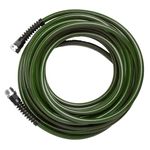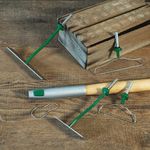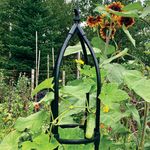‘Empress of India’ nasturtiums are absolutely stunning cascading from hanging baskets. With their vibrant red flowers and lush green foliage, they’ll bring an explosion of color to any porch or patio. Growing these beauties is easy and rewarding. Follow this guide for tips on selecting the perfect basket, sowing seeds, and caring for your nasturtiums so you can create a spectacular display.
Choosing the Right Basket for Cascading Color
The first step in growing cascading ‘Empress of India’ nasturtiums is selecting the right hanging basket. A wire or metal basket 12-16 inches wide with a coco fiber liner is ideal. The wire allows for good airflow while the coco fiber liner helps retain moisture. Good drainage is key to prevent fungal diseases like root rot.
Match the basket size to the fullness you want. A 12 inch basket is great for showcasing a single nasturtium variety like ‘Empress of India’. For a lush, overflowing look, go bigger with a 14-16 inch basket. This allows you to plant a blend of nasturtium varieties for added interest.
Sowing Seeds for Success
‘Empress of India’ nasturtiums grow quickly and easily from seed Sow them directly into your hanging basket Fill the lined basket with a quality potting mix blended with equal parts compost and perlite or vermiculite to improve drainage.
Moisten the soil then plant 2-3 seeds per hole, 1 inch deep and 1 inch apart. Nasturtium seeds are fairly large and easy to handle. Cover lightly with potting mix.
Place the basket in full sun and keep the soil consistently moist until the seeds germinate in 1-2 weeks. Thin seedlings to the strongest one per hole.
Caring for Your Cascading Beauties
Watering
Nasturtiums prefer drier soil once established. Allow the top inch of soil to dry between waterings. Water thoroughly until it drains from the bottom then allow to dry. Consistent moisture is key in the first few weeks after sowing.
Use a spray bottle to gently mist new seedlings, Soak established plants deeply but infrequently Proper drainage prevents diseases
Light
Sun lovers, nasturtiums need at least 6-8 hours of direct sun daily for best growth and maximum blooms. Morning sun is ideal in hot climates. Insufficient light causes leggy, weak growth.
Fertilizer
Nasturtiums are not heavy feeders but you can boost blooms with occasional fertilizing. Use a liquid flowering plant fertilizer at half strength every 2-3 weeks once buds appear. Overfeeding causes excess foliage over flowers.
Support
Add a trellis or plant rings to the basket to support trailing growth. Gently tie vines to supports as they grow. This encourages upward and cascading growth for added dimension.
Pinching
Pinch off spent blooms to encourage continuous flowering. Prune any leggy growth to promote bushiness.
Pests
Aphids and whiteflies may attack. Use insecticidal soap or neem oil to control. Prevent fungal issues with good air circulation and proper watering.
Enjoying the Bounty
Your basket will soon be overflowing with vibrant red blooms and trailing foliage. Snip a few flowers to display in a vase or use the edible blooms and peppery leaves in salads.
At the end of the season, collect dried seed pods to save seeds for next year. With proper care, ‘Empress of India’ nasturtiums will give you months of vivid color in hanging baskets, beds, or containers.

Plant Characteristics are only available to Fine Gardening members
Sign up for a free trial and get instant access to our complete plant guide as well as our entire collection of articles and videos.
Tropaeolum majus ‘Empress of India’

This old-fashioned cultivar has a mounding habit and grows to a foot tall and wide. In summer and fall, it bears double, deep scarlet flowers. The rounded leaves and five-petaled flowers are edible.
Noteworthy CharacteristicsThese annuals are native to South America. They are suitable for garden edges, herb gardens, covering banks, hanging baskets, and other containers.
CareProvide moist, well-drained soil in full sun. T. majus flowers best when grown in lean soil.
PropagationSow seeds indoors in early spring, or in situ in midspring.
ProblemsCaterpillars, flea beetles, black aphids, slugs, whiteflies, viruses.
Fine Gardening Recommended Products
Fine Gardening receives a commission for items purchased through links on this site, including Amazon Associates and other affiliate advertising programs. – Slim, lightweight design, is made with toxin-free polyurethane and utilizes industrial grade, lead-free fittings – 3 Pounds – 1200″L x 0.43″W – Manufactured in the USA
Johnny’s Selected Seeds Connecta® Cultivation Kit
Fine Gardening receives a commission for items purchased through links on this site, including Amazon Associates and other affiliate advertising programs. Choose the right tool head for the job and switch out quickly with a simple push-button release. Includes the Connecta receiver, Connecta Collinear 4 head, Connecta Collinear 7 head, Connecta Contour Wire 4 head, Connecta Contour Wire 6 head, a sustainably harvested oiled ashwood handle, and a stainless-steel carrying clip.
Lee Valley Garden Obelisks
Fine Gardening receives a commission for items purchased through links on this site, including Amazon Associates and other affiliate advertising programs. Sturdy yet lightweight, these obelisks provide ample support for climbing plants while being easy to install and move. The medium obelisk stands 68 1/2″ high overall with a diameter of about 9 1/2″, compact enough for smaller containers indoors or out. The large size stands 86 1/2″ high with a diameter of 15 3/4″, ideal for larger outdoor spaces and containers.
- Genus : Tropaeolum
- Plant Height : 6 to 12 inches
- Plant Width : 6 to 12 inches
- Plant Type : Annuals
- Uses : Containers, Ground Covers
- Bloom Time : Fall, Summer
- Growth Rate : Fast
- Characteristics : Fragrant Flowers, Self Seeds, Showy Foliage
- Light : Full Sun to Partial Shade
- Maintenance : Low
- Moisture : Medium Moisture
- Flower Color : Red
- Plant Seasonal Interest : Summer Interest
Nasturtium Empress of India – Seeds Review
FAQ
Is empress of India nasturtium trailing?
Nasturtium Empress of India is a dwarf, non-trailing Nasturtium with stunning scarlet flowers and deep, blue-green leaves. Plants are easy to grow and long-blooming.
Can you put nasturtium in a hanging basket?
Nasturtiums, impatiens, begonias, lobelia, and petunias are excellent traditional options for hanging baskets, or you could branch out and try something new with trailing snapdragons and pansies, portulaca, dichondra, and even a few vining vegetables like cherry tomatoes and peas.
What are the best nasturtiums for hanging baskets?
Gleam Mix Nasturtium. This is the variety we would recommend for most hanging baskets and moderate spreading. The vines are substantially longer than Jewel but much shorter than the tall climbing single.
Do the nasturtium empress of India climb?
Mounding Nasturtiums form a neat, round bundle, usually about 10 to 12″ wide and slightly less tall. Trailing, or vining, varieties can climb 5′ or more if given a trellis, or can be allowed to sprawl and ramble on the ground. They also look good as the spiller accent in pots.



